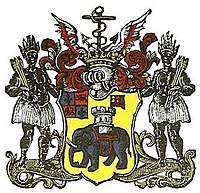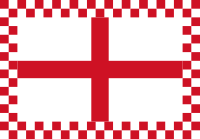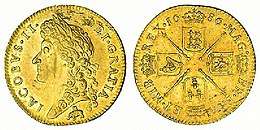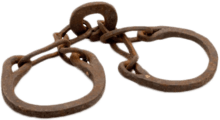Royal African Company
The Royal African Company (RAC) was an English mercantile (trading) company set up in 1660 by the royal Stuart family and City of London merchants to trade along the west coast of Africa.[1] It was led by the Duke of York, who was the brother of Charles II and later took the throne as James II. It shipped more African slaves to the Americas than any other institution in the history of the Atlantic slave trade.[2]
 Coat of arms | |
 Company flag (c. 1665) | |
Formerly | Company of Royal Adventurers Trading to Africa |
|---|---|
| Private | |
| Industry | Mercantile trading |
| Predecessor | Company of Royal Adventurers Trading into Africa |
| Founded | 1660 in London, England |
| Founders | House of Stuart (British Royal Family) |
| Defunct | 1752 |
| Headquarters | |
Key people | James II, Charles II |
| Products | Gold, silver, ivory, humans |
It was established after Charles II gained the English throne in the Restoration of 1660.[3] While its original purpose was to exploit the gold fields up the Gambia River, which were identified by Prince Rupert during the Interregnum, it soon developed and led a brutal and sustained slave trade.[2] It also extracted other commodities, mainly from the Gold Coast. After becoming insolvent in 1708, it survived in a state of much reduced activity until 1752 when its assets were transferred to the new African Company of Merchants, which lasted until 1821.
History
Background
In the 17th century the settlements on the west coast of Africa, though they had an important trade of their own in gold and ivory, existed chiefly for the supply of slaves to the West Indies and America. On the west coast the Europeans lived in fortified factories (trading posts) but had no sovereignty over the land or its natives. The coastal tribes acted as intermediaries between them and the slave-hunters of the interior. There was little incentive for white men to explore up the rivers, and few of them did so. The atmosphere might have been one of quiet routine had there not been acute rivalries between the European powers; especially the Dutch, who made use of native allies against their rivals. Before the Restoration the Dutch had been the main suppliers of slaves to the English West Indian plantations, but it was part of the policy of the English Navigation Acts to oust them from this lucrative trade.[4]
Foundation and early years

Originally known as the Company of Royal Adventurers Trading into Africa, by its charter issued in 1660 it was granted a monopoly over English trade along the west coast of Africa, with the principal objective being the search for gold. In 1663 a new charter was obtained which also mentioned the trade in slaves.[5] This was the third English African Company, but it made a fresh start in the slave trade and there was only one factory of importance for it to take over from the East India Company, which had leased it as a calling-place on the sea-route round the Cape. This was Cormantin, a few miles east of the Dutch station of Caso Corso or Cape Coast Castle. In 1663, as a prelude to the Dutch war, Captain Holmes's expedition captured or destroyed all the Dutch settlements on the coast, and in 1664 Fort James was founded on an island about twenty miles up the Gambia river, as a new centre for English trade and power. This, however, was only the beginning of a series of captures and recaptures. In the same year de Ruyter won back all the Dutch forts except Cape Coast Castle and also took Cormantin. The treaty of Breda confirmed Cape Coast Castle to the English.[4][6]
Forts served as staging and trading stations, and the Company was responsible for seizing any English ships that attempted to operate in violation of its monopoly (known as interlopers). In the "prize court", the King received half of the proceeds and the Company half from the seizure of these interlopers.[7]
The Company fell heavily into debt in 1667, during the Second Anglo-Dutch War. For several years after that, the Company maintained some desultory trade, including licensing single-trip private traders, but its biggest effort was the creation in 1668 of the Gambia Adventurers.[8] This new company was separately subscribed and granted a ten-year licence for African trade north of the Bight of Benin with effect from 1 January 1669.[9] At the end of 1678, the licence to the Gambia Adventurers expired and its Gambian trade was merged into the Company.[10]
The African Company was ruined by its losses and surrendered its charter in 1672, to be followed by the still more ambitious Royal African Company of England. Its new charter was broader than the old one and included the right to set up forts and factories, maintain troops, and exercise martial law in West Africa, in pursuit of trade in gold, silver and African slaves.[11] Until 1687 the Company was very prosperous. It set up six forts on the Gold Coast, and another post at Ouidah, farther east on the Slave Coast, which became its principal centre for trade. Cape Coast Castle was strengthened and rose to be second in importance only to the Dutch factory at Elmina. Anglo-Dutch rivalry was, however, henceforward unimportant in the region and the Dutch were not strong enough to take aggressive measures here in the Third Anglo-Dutch War.[4]
Slave trade
In the 1680s the Company was transporting about 5,000 enslaved people a year to markets primarily in the Caribbean across the Atlantic. Many were branded with the letters "DY", for its Governor, the Duke of York, who succeeded his brother on the throne in 1685, becoming King James II. Other slaves were branded with the company's initials, RAC, on their chests.[12] Historian William Pettigrew has stated that this company “shipped more enslaved African women, men and children to the Americas than any other single institution during the entire period of the transatlantic slave trade,” and that investors in the company were fully aware of its activities and intended to profit from this exploitation.[13]
Between 1662 and 1731, the Company transported approximately 212,000 slaves, of whom 44,000 died en route. By that time, they also transported slaves to English colonies in North America.[14]
Later activities and insolvency
From 1694 to 1700, the Company was a major participant in the Komenda Wars in the port city Komenda in the Eguafo Kingdom in modern-day Ghana. The Company allied with a merchant prince named John Cabess and various neighbouring African kingdoms to depose the king of Eguafo and establish a permanent fort and factory in Komenda.[15] The English took two French forts and lost them again, after which the French destroyed Fort James. The place appears to have been soon regained and in the War of Spanish Succession to have been twice retaken by the French. In the treaty of Utrecht it remained English. The French wars caused considerable losses to the Company.[4]
In 1689, the Company acknowledged that it had lost its monopoly with the end of royal power in the Glorious Revolution, and it ceased issuing letters of marque.[16] Edward Colston transferred a large segment of his original shareholding to William III at the beginning of 1689, securing the new regime's favour.[17] To maintain the Company and its infrastructure and end its monopoly, parliament passed the Trade with Africa Act 1697 (9 Will. 3 c. 26).[18] Among other provisions, the Act opened the African trade to all English merchants who paid a ten per cent levy to the Company on all goods exported from Africa.[19]
The Company was unable to withstand competition on the terms imposed by the Act and in 1708 became insolvent, surviving until 1750 in a state of much reduced activity.[4]
The Company continued purchasing and transporting slaves until 1731, when it abandoned slaving in favour of ivory and gold dust.[20]
From 1668 to 1722, the Royal African Company provided gold to the English Mint. Coins made with such gold are designed with an elephant below the bust of the king and/or queen. This gold also gave the coinage its name, the guinea.[21]
Members and officials
At its incorporation, the constitution of the company specified a Governor, Sub Governor, Deputy Governor and 24 Assistants.[22] The Assistants (also called Members of the Court of Assistants) can be considered equivalent to a modern day board of directors.[23][24]
- James Stuart, Duke of York, the future King James II – Governor of the Company from its creation and its largest shareholder[25]
- Edward Colston (1636–1721), merchant, philanthropist, and Member of Parliament, was a shareholder in the Royal African Company from 1680 to 1692; from 1689 to 1690 he was its Deputy Governor, a senior executive position, the basis on which he is described as a slave trader.[26]
- Charles Hayes (1678–1760), mathematician and chronologer, was sub-governor of the Royal African Company in 1752, when it was dissolved.[27]
List of notable investors and officials
- Charles II of England[28]
- Sir Edmund Andros[29]
- Sir John Banks[30]
- Benjamin Bathurst, Deputy Governor of the Leeward Islands[31]
- Henry Bennet, 1st Earl of Arlington[29]
- Lord Buckingham[29]
- Sir Josiah Child[30]
- Sir Robert Clayton[32]
- Sir George Carteret[29]
- Sir Peter Colleton[29]
- Anthony Ashley Cooper, 1st Earl of Shaftesbury[33]
- Earl of Craven[29]
- Lawrence Du Puy[29]
- Sir Samuel Dashwood[28]
- Ferdinand Gorges[29]
- Francis, Lord Hawley[29]
- Sir Jeffrey Jeffreys, Commander of affairs of Leeward Isles in England 1690–c.1696, Assistant to the Royal African Company 1684–6, 1692–8[34]
- John Locke[35]
- Sir John Moore[28]
- Samuel Pepys[36]
- James Phipps of Cape Coast Castle[37]
- Thomas Povey[29]
- Sir William Prichard[28]
- Sir Gabriel Roberts[28]
- Prince Rupert[29]
- Tobias Rustat[29]
- George Villiers[29]
- Matthew Wren[29]
Dissolution
The Royal African Company was dissolved by the African Company Act 1750, with its assets being transferred to the African Company of Merchants. These principally consisted of nine trading posts on the Gold Coast known as factories: Fort Anomabo, Fort James, Fort Sekondi, Fort Winneba, Fort Apollonia, Fort Tantumquery, Fort Metal Cross, Fort Komenda, and Cape Coast Castle, the last of which was the administrative centre.[38]
See also
Notes
- "The King Grants the Right to Trade in Africa". National Archives. Retrieved 18 August 2020.
- Jesus College Cambridge Legacy of Slavery Working Party (25 November 2019). Jesus College Legacy of Slavery Working Party Interim Report (July-October 2019) (Report). pp. 9–10.
- Carrington, Charles (1950). The British Overseas: Exploits of a Nation of Shopkeepers. Cambridge, England: Cambridge University Press. p. 217. OCLC 1083162.
- Clark, Sir George (1956). The Later Stuarts, 1660–1714. The Oxford History of England: Oxford University Press. p. 331–333. ISBN 0-19-821702-1.
- Davies, K. G. (Kenneth Gordon) (1999) [originally published in London by Longmans, Green & Co in 1957.]. The Royal African Company. London: Routledge/Thoemmes Press. p. 41. ISBN 041519072X. OCLC 42746420.
- Zook, George Frederick (1919). The Company of Royal Adventurers Trading Into Africa. Lancaster, Pennsylvania: Press of the New Era Printing Company. p. 20. also published as Zook, George Frederick (1919). "The Company of Royal Adventurers Trading Into Africa". The Journal of Negro History. 4 (2): 134–231, page 155. doi:10.2307/2713534. JSTOR 2713534.
- Davies, Kenneth Gordon (1999). The Royal African Company. Routledge/Thoemmes Press. p. 106. ISBN 978-0-415-19077-0., originally published in London by Longmans, Green in 1957.
- Sometimes known as The Gambian Merchants' Company.
- Zook 1919, p. 23
- Davies 1999, p. 215
- Kitson, Frank. (1999) Prince Rupert: Admiral and General-at-Sea. London: Constable, p. 238.
- Micklethwait, John, and Adrian Wooldridge. The Company: A Short History of a Revolutionary Idea. New York: Modern Library, 2003. ISBN 0-679-64249-8.
- "Legacy of Slavery Working Party recommendations". Jesus College, Cambridge. Retrieved 5 July 2020.
- "Voyages Database". www.slavevoyages.org. Retrieved 19 November 2018.
- Law, Robin (2007). "The Komenda Wars, 1694–1700: a Revised Narrativ". History in Africa. 34: 133–168. doi:10.1353/hia.2007.0010. S2CID 165858500.
- Davies 1999, p. 123
- Gardiner, Juliet (2000). The History Today Who's Who In British History. London: Collins & Brown Limited and Cima Books. p. 192. ISBN 1-85585-876-2.
- "William III, 1697-8: An Act to settle the Trade to Africa. [Chapter XXVI. Rot. Parl. 9 Gul. III. p. 5. n. 2.] | British History Online". www.british-history.ac.uk.
- P. E. H. Hair & Robin Law, 'The English in West Africa to 1700', in The Oxford History of the British Empire: Volume 1, The Origins of Empire: British Overseas Enterprise to the close of the Seventeenth Century, ed. Nicholas Canny (Oxford : Oxford University Press, 1998), p. 259
- "Royal African Company of England". Archives Hub. Retrieved 6 July 2020.
- Davies 1999, p. 181
- Davies, Kenneth Gordon (1975). The Royal African Company. Octagon Books. ISBN 0-374-92074-5. OCLC 831375484.
- Evans, Chris, 1961- (2010). Slave Wales : the Welsh and Atlantic slavery, 1660-1850. University of Wales Press. ISBN 978-0-7083-2303-8. OCLC 653083564.CS1 maint: multiple names: authors list (link)
- Dresser, Madge (1 October 2007). "Set in Stone? Statues and Slavery in London". History Workshop Journal. 64 (1): 162–199. doi:10.1093/hwj/dbm032. ISSN 1363-3554. S2CID 194951026.
- Robbins, James S. (2018). Erasing America: Losing Our Future by Destroying Our Past. Regnery. ISBN 978-1621578161.
- Statue of Edward Colston A Grade II Listed Building in Bristol, listing at britishlistedbuildings.co.uk, accessed 10 June 2020
-

- Andrea Colli (22 December 2015). Dynamics of International Business: Comparative Perspectives of Firms, Markets and Entrepreneurship. Routledge. p. 46. ISBN 978-1-317-90674-2.
- Pettigrew, William Andrew (2013). Freedom's Debt: The Royal African Company and the Politics of the Atlantic Slave Trade, 1672–1752. UNC Press Books. p. 25. ISBN 9781469611815.
- Blackburn, Robin (1998). The Making of New World Slavery: From the Baroque to the Modern, 1492–1800. Verso. p. 255. ISBN 9781859841952.
- "Estates within 10 miles of Bristol | Profits | From America to Bristol | Slavery Routes | Bristol and Transatlantic Slavery | PortCities Bristol". discoveringbristol.org.uk. Retrieved 9 June 2020.
- Harris, Tim; Taylor, Stephen (15 October 2015). The Final Crisis of the Stuart Monarchy: The Revolutions of 1688–91 in Their British, Atlantic and European Contexts. Boydell & Brewer. ISBN 9781783270446.
- Spurr, John (2011). Anthony Ashley Cooper, First Earl of Shaftesbury 1621–1683. Ashgate. ISBN 978-0754661719.
- Kaufman, Miranda (2007). English Heritage Properties 1600–1830 and Slavery Connections: A Report Undertaken to Mark the Bicentenary of the Abolition of the British Atlantic Slave Trade. English Heritage.
- John Locke at National Portrait Gallery, London, accessed 9 June 2020
- "Samuel Pepys - National Portrait Gallery". www.npg.org.uk.
- David Henige, “Companies Are Always Ungrateful”: James Phipps of Cape Coast, A Victim of the African Trade, African Economic History (No.9, 1980), at pages 27-47
- Adams, Robert; Adams, Charles (2005). The Narrative of Robert Adams, A Barbary Captive: A Critical Edition. Cambridge: Cambridge University Press.
